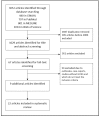Occupational Infection Risk with Multidrug-Resistant Organisms in Health Personnel-A Systematic Review
- PMID: 31167449
- PMCID: PMC6604006
- DOI: 10.3390/ijerph16111983
Occupational Infection Risk with Multidrug-Resistant Organisms in Health Personnel-A Systematic Review
Abstract
The increase in multi-drug-resistant organisms (MDROs) in the last years has become a public health problem. MDROs are partially responsible for numerous nosocomial infections, extended hospital stays, high costs, and high mortality. In addition to methicillin-resistant Staphylococcus aureus (MRSA) and vancomycin-resistant enterococci (VRE), Gram-negative bacteria are also a key area of focus. The knowledge of MDROs among the medical staff in the occupational context is limited, with the exception of MRSA. Therefore, a systematic review was carried out to determine the occupational risk for employees posed by MDROs. The search included studies from the year 2000 onwards among personnel who had contact with MDROs. A total of 22 primarily cross-sectional studies in hospital or geriatric care settings were found, with large differences regarding number of participants, examination method, inclusion of a control group, and study quality. The most frequently examined pathogens were extended-spectrum ß-lactamase (ESBL)-producing bacteria with a prevalence of 2.6-48.5%, VRE (0-9.6%), and MRSA (0.9-14.5%). There are only few qualitatively good studies available on MDROs' risk infection for employees in the health service. Any comparison of the results was limited by data heterogeneity. More research is required to describe the occupational risk of infection with MDROs.
Keywords: colonization; health personnel; multidrug-resistant organisms; occupational exposure.
Conflict of interest statement
The authors declare no conflict of interest.
Figures
References
-
- Oberdörfer H., Hübner C., Linder R., Fleßa S. Additional Costs for Care of Patients with Multi-Resistant Pathogens–An Analysis from the Perspective of a Statutory Health Insurance. Gesundheitswesen. 2015;77:854–860. - PubMed
-
- Noll I., Eckmanns T. Antibiotikaresistenz: Vergleich mit europäischen Daten. Dtsch. Arztebl. 2017;114:A2209–A2210.
-
- European Centre for Disease Prevention and Control . Surveillance of Antimicrobial Resistance in Europe—Annual Report of the European Antimicrobial Resistance Surveillance Network (EARS-Net) 2017. ECDC; Stockholm, Sweden: 2018.
Publication types
MeSH terms
Substances
LinkOut - more resources
Full Text Sources
Medical



